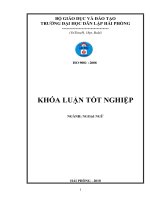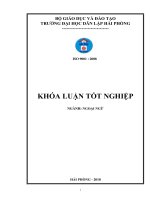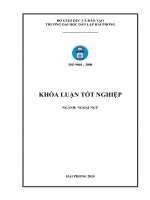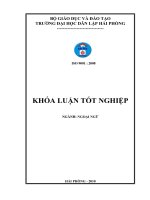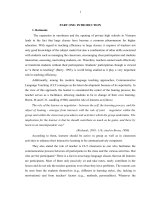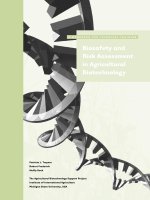Study on flood risk assessment in downstream area in ke go reservoir, ha tinh province
Bạn đang xem bản rút gọn của tài liệu. Xem và tải ngay bản đầy đủ của tài liệu tại đây (2.64 MB, 94 trang )
MINISTRY OF EDUCATION AND
TRAINING
MINISTRY OF AGRICULTURE AND
RURAL DEVELOPMENT
THUYLOI UNIVERSITY
STUDY ON FLOOD RISK ASSESSMENT IN DOWNSTREAM
AREA OF KE GO RESERVOIR, HA TINH PROVINCE
Tran Ngoc Huan
MSc Thesis on Intergrated Water Resources Management
Hanoi, 2015
MINISTRY OF EDUCATION AND
TRAINING
MINISTRY OF AGRICULTURE AND
RURAL DEVELOPMENT
THUY LOI UNIVERSITY
Tran Ngoc Huan
STUDY ON FLOOD RISK ASSESSMENT IN DOWNSTREAM
AREA IN KE GO RESERVOIR, HA TINH PROVINCE
Major: Intergrated Water Resources Management
THESIS OF MASTER DEGREE
Supervisor: Asso. Prof. Dr. Pham Thi Huong Lan
This research is done for a partial fulfilment of the requirement for
Master of Science Degree at Thuyloi University
This Master Programme is supported by NICHE – VNM 106 Project
Hanoi, 2015
Abstract
Flooding causes economic, social and environmental damages and life loss. This
fact increases the great attention on flooding by government, and science in many
countries around the world. As a country located in the tropical climate region,
Vietnam has been facing various water related disasters since ancient time,
particularly in central parts of Vietnam where featured by steep topography. In
recent years, Rao Cai river basin in Ha Tinh province is frequently flooded due to
climate change impact, rapid infrastructure and urbanization growth. This problem
caused serious damages to human life, properties, and social – economic
development activities…
Flood risk management is a new concept based on a proactive approach which
recently becomes a robust tool for reducing flood damage. Main contents of flood
risk management are flood risk assessment and flood preventive measures or flood
preventive planning. Flood risk assessment is key part in flood risk management.
Flood risk assessment is a function of three main variables: flood hazards,
vulnerability, and coping capacity. Understanding of flood hazards, vulnerability,
and coping capacity is the vital step for efficiency of flood risk assessment. Flood
risk management strategies have not been developed for Rao Cai river basin for
many years and there is no spatial planning approach for regional development.
This research aims at flood risk assessment for Rao Cai river basin based on the
new concept of flood risk management mentioned above. An incorporated
hydrological modeling approach for hazard assessment for Rao Cai river basin has
been adopted in this research. The research objective divides into three parts: (1)
Identification of flooding and potential reasons based on available natural, social
and economic data; (2) The second part involved flood simulation and inundation
mapping of events with chosen return periods using a MIKE package model (MIKE
UHM, MIKE 11, and MIKE 11 GIS).The model was calibrated and verified based
on the data series in October, 2010. A flood from 2nd to 6th, October 2010 was used
to calibrate the model. Another flood in October, 2010 (from 14th to 19th, October)
was used to verify the model. Results of calibration and verification were fit to
measured data. The flood simulations for selected return periods were generated for
200 and 1000 years corresponding to frequency of design and checking flood of Ke
Go reservoir. (3) Flood risk assessment is combined effect of flood depth (hazard
factor) and population density (vulnerability factor) by weighing factors for both of
them. As for the results, the research revealed that flood risk assessment is helpful
tool for flood risk management.
Flood risk maps were produced for the flood of 1000 year and 200 year return
period. The level of hazard and risk were determined for each community in Cam
Xuyen, Thach Ha and Ha Tinh city. These maps can be used for flood risk
management and mitigation planning for Ha Tinh province in general, Rao Cai river
basin in particular.
Declaration
I hereby certify that the work which is being presented in this thesis entitled, “Study
on flood risk assessment in downstream area in Ke Go reservoir, Ha Tinh
province” in partial fulfillment of the requirement for the award of the Master of
Science in Integrated Water Resource Management, is an authentic record of my
own work carried out under supervision of Asso. Prof. Dr. Pham Thi Huong Lan.
The matter embodied in this thesis has not been submitted by me for the award of
any other degree or diploma.
Date: February 15, 2015
Tran Ngoc Huan
Acknowledgements
I would like to express my sincere gratitude to my advisor Asso. Prof. Dr Pham
Thi Huong Lan for her guidance, suggestion and inspiration.
I would also like to acknowledge Dr. Vu Thanh Tu, Mr Duong Hai Thuan and Dr.
Bui Du Duong for their comments and suggestion.
I would like to thank the Hanoi University for Natural Resources and Environment,
Ministry of Natural Resources and Environment, Vietnam and NICHE – VNM
106 Project for the award of a scholarship and also Hanoi Water Resources
University for giving me the opportunity for this special study.
I also wish to thank members of the master thesis committee consist of Prof.Dr.
Nguyen Quan Kim (chairman), Asso.Prof.Dr. Mai Van Cong (examination),
Asso.Prof.Dr. Nguyen Mai Dang (examination), Dr Le Viet Son and Dr Dinh
Thanh Mung for their comments, examination, and corrections.
Finally, I would like to express my special appreciation to my friends and
colleagues for their supports, encourages and advices. The deepest thanks are
expressed to my family members for their unconditional loves.
i
TABLE OF CONTENTS
CHAPTER 1 - INTRODUCTION ........................................................................... 1
1.1. Problem statement ............................................................................................ 1
1.2. Research objectives .......................................................................................... 3
1.3. Scope of study...................................................................................................3
1.4. Structure of thesis ............................................................................................. 3
CHAPTER 2: LITERATURE REVIEW ................................................................ 5
2.1. Concepts of flood risk, hazard and vulnerability .............................................. 5
2.2. Flood risk assessment ....................................................................................... 7
2.3. Previous studies in study area ........................................................................... 9
CHAPTER 3: DESCRIPTION OF STUDY AREA............................................. 10
3.1. Physical characteristics ................................................................................... 10
3.1.1. Location of this basin ............................................................................... 10
3.1.2. Topography conditions ............................................................................. 11
3.1.3. Hydro-meteorological characteristics ...................................................... 12
3.2. Social and economic characteristics ............................................................... 16
3.2.1. Population .................................................................................................16
3.2.1. Rural area .................................................................................................17
3.3. Reservoir and current irrigation system.......................................................... 18
3.3.1. Overview of Ke Go reservoir ................................................................... 18
3.3.2. Irrigation system ....................................................................................... 21
3.4. Flooding situation in downstream area ........................................................... 22
3.4.1. The flooding events occurred in 2010 ...................................................... 22
3.4.2. The flooding events occurred in 2012 ...................................................... 25
3.4.3. The flooding events occurred in 2013 ...................................................... 26
CHAPTER 4: METHODOLOGY AND DATA USED ....................................... 28
4.1. General framework ......................................................................................... 28
4.1.1. Methods to flood risk assessment............................................................. 29
4.1.2. Method for estimating design hyetograph ................................................ 30
ii
4.1.3. Method for developing design hydrograph on lateral flow in downstream
............................................................................................................................ 31
4.1.4. Method for simulation floods corresponding to various return period .... 31
4.1.5. Method for inundation mapping ............................................................... 31
4.2. Governing equation in MIKE package ........................................................... 31
4.2.1. Rainfall runoff model (MIKE - Unit hydrograph model) ........................ 32
4.2.2. Hydrodynamic model (MIKE 11 HD) ..................................................... 33
4.2.3. Identification of inundation maps ............................................................ 34
4.3. Data used ........................................................................................................ 35
4.3.1. Data collection .......................................................................................... 35
4.3.2. Data analysis............................................................................................. 36
CHAPTER 5: RESULTS AND DISSCUSIONS .................................................. 40
5.1. The reasons cause the flooding in downstream area ...................................... 40
5.1.1. Climate change impacts............................................................................ 40
5.1.2. Infrastructure impacts ............................................................................... 43
5.2. Flood hazard ................................................................................................... 43
5.2.1. Rainfall runoff modeling .......................................................................... 43
5.2.2. Flood modeling......................................................................................... 50
5.2.3. Flood hazard maps.................................................................................... 58
5.3. Flood vulnerability.......................................................................................... 62
5.4. Flood risk in downstream area of the Ke Go reservoir................................... 65
CHAPTER 6: CONCLUSIONS AND RECOMMENDATIONS ................... 70
6.1. Conclusions..................................................................................................... 70
6.2. Recommendations........................................................................................... 71
REFERENCES ........................................................................................................ 73
APPENDIX .............................................................................................................. 76
Appendix 1: Frequency curve of maximum rainfall during 1 day of stations....... 77
Appendix 2: Roughness coefficient ....................................................................... 81
iii
LIST OF TABLES
Table 3- 1 Lists of meteorological stations ............................................................... 12
Table 3- 2: The average of monthly rainfall at Ha Tinh station from 1975 - 2010 ..14
Table 3- 3: Monthly discharge of Ke Go reservoir from 1957 - 2010 ...................... 15
Table 3- 4: Population pattern ................................................................................... 16
Table 3- 5: Land use ..................................................................................................17
Table 3- 6: Technical parameters of reservoir .......................................................... 19
Table 3- 7: Parameters of junction work items ......................................................... 19
Table 3- 8: Technical parameters of Irrigation channels system .............................. 21
Table 3- 9: Statistic of damages caused by rainfall and flood at Ha Tinh city, Thach
Ha and Cam Xuyen district occurred from 14 October to 19, October, 2010 .......... 24
Table 4- 1 Database used for research ...................................................................... 36
Table 5 - 1: Result of frequency analysis of maximum daily rainfall ...................... 44
Table 5 - 2: Value of design rainfall distribution of Ha Tinh, Ky Anh and Huong
Khe stations during 1 day corresponding to difference frequency (daily rainfall) ... 44
Table 5 - 3: Sub-catchment of Rao Cai river basin and weighting factors of
meteorological station ............................................................................................... 46
Table 5 - 4: Parameters of UHM in MIKE RR model of Ke Go catchment............. 47
Table 5 - 5: Different in peaks of observed and simulated discharge for calibration
mode at Ke Go reservoir ........................................................................................... 48
Table 5 - 6: Different in peaks of observed and simulated discharge in verification
at Ke Go reservoir ..................................................................................................... 48
Table 5 - 7: Parameters of UHM - SCS for Rao Cai’s sub-catchments .................... 50
Table 5 - 8. Runoff link of sub-catchments into river network in MIKE 11 model .53
Table 5 - 9: Monitoring points for the calibrating and verifying hydraulic model ... 53
Table 5 - 10: Results of flood simulation form 2nd Oct to 6th Oct, 2010 for
calibration of MIKE 11 HD model ........................................................................... 55
Table 5 - 11: Results of flood simulation from 12 Oct to 18 Oct- 2010 ................... 57
Table 5 - 12: Maximum water level corresponding to design and checking flood of
Ke Go reservoir ......................................................................................................... 57
Table 5 - 13. Designed flooding hazard level scale for the downstream of the Ke Go
reservoir ..................................................................................................................... 58
Table 5 - 14. Flood hazard areas for flood event in 2010 ......................................... 60
iv
Table 5 - 15. Flood hazard areas corresponding to design and checking flood ........ 62
Table 5 - 16. Criteria of vulnerability map derived from population density for the
downstream of the Ke Go reservoir .......................................................................... 63
Table 5 - 17. Criteria of vulnerability map derived from population density for the
downstream of the Ke Go reservoir .......................................................................... 65
Table 5 - 18. Flood risk map for the downstream area of Ke Go catchment in flood
in October, 2010 ........................................................................................................ 65
Table 5 - 19. Statistic table of flood risk of different floods ..................................... 68
v
LIST OF FIGURES
Figure 3- 1: Map of study area .................................................................................. 10
Figure 3- 2: Topography of Rao Cai river basin in ASTER global DEM ................ 11
Figure 3- 3: Hydro-meteorological station network of Rao Cai river basin ............. 13
Figure 3- 4: The average of monthly rainfall at Ha Tinh station from 1975 - 2010 .14
Figure 3- 5: Monthly discharge flow into Ke Go reservoir ...................................... 16
Figure 3- 6: The spillway of Ke Go Reservoir, there are two arc gates ................... 19
Figure 3- 7: The Emergency spillway of Ke Go reservoir ........................................ 19
Figure 3- 8: Flood at Ha Tinh city in October, 2010 ................................................ 23
Figure 3- 9: Percentage of damages in terms of money for various categories
occurred from 14th to 19th, October, 2010 .................................................................25
Figure 3- 10: Flood at Ha Tinh city in October, 2012 .............................................. 26
Figure 3- 11: Inundation in the downstream of Ke Go reservoir in June 2nd 2013... 27
Figure 3- 12: Flood in Ha Tinh city in October, 2013 .............................................. 27
Figure 4 - 1: Illustration of the research methodology.............................................. 29
Figure 4 - 2: Mass flow rate in and out of an elementary control volume ................ 34
Figure 4 - 3: MIKE 11 GIS Input and Output ........................................................... 35
Figure 4 - 4: Inflow of Ke Go reservoir in October, 2010 ........................................ 37
Figure 4 - 5: Inflow of Ke Go reservoir in October, 2013 ........................................ 37
Figure 4 - 6: Water level at Phu and Hoi Bridge station in October, 2010 ............... 38
Figure 5 - 1: Annual rainfall change on the Rao Cai river basin from 1975 – 2005 41
Figure 5 - 2: Changing of maximum rainfall of Ha Tinh station .............................. 42
Figure 5 - 3: Inflow of Ke Go reservoir and actual rainfall 2013 ............................. 43
Figure 5 - 4: Rao Cai watershed sub-basin schematizations and Thiessen polygon
weighting computation of mean rainfall of sub-catchment in Rao Cai river basin ..45
Figure 5 - 5: Parameters of UHM in MIKE RR model of Ke Go catchment ........... 47
Figure 5 - 6: Observation and simulation of hourly discharge of Ke Go reservoir
from 2 Oct to 6 Oct – 2010 for calibration model .................................................... 47
Figure 5 - 7: Observed and simulated hourly discharge of Ke Go reservoir from 14
Oct to 19 Oct – 2010 – Verification .......................................................................... 48
Figure 5 - 8: Flood at Ke Go reservoir in 16 October 2013 ...................................... 49
Figure 5 - 9: Hydraulic calculation network in downstream of Ke Go reservoir ..... 51
vi
Figure 5 - 10: Storage capacity of floodplain in downstream ................................... 52
Figure 5 - 11: Calculated and measured water level at Cau Phu (2 nd to 6th October,
2010).......................................................................................................................... 54
Figure 5 - 12: Calculated and measured water level at Cau Ho (2 nd to 6th October,
2010).......................................................................................................................... 55
Figure 5 - 13: Calculated water level and measured water level at Cau Phu(12 Oct to
18 Oct- 2010) ............................................................................................................ 56
Figure 5 - 14: Calculated water level and measured water level at Hoi Bridge (12
Oct to 18 Oct- 2010) .................................................................................................56
Figure 5 - 15. Some typical picture to determine flood hazard threshold................. 60
Figure 5 - 17. Flood hazard map of 0.5% design flood event ................................... 61
Figure 5 - 18. Flood hazard map of 0.1% design flood event ................................... 62
Figure 5 - 19: Frequency distribution of population of study area ........................... 63
Figure 5 - 20: Frequency distribution of population density of study area ............... 63
Figure 5 - 21: Vulnerability map in Rao Cai river basin .......................................... 64
Figure 5 - 22. Designed risk level for the downstream of the Ke Go reservoir ........ 65
Figure 5 - 23. Flood risk map for the downstream area of Ke Go river basin of flood
in October, 2010 ........................................................................................................ 66
Figure 5 - 24. Flood risk map for 0.5% design flood ................................................ 67
Figure 5 - 25. Flood risk map for 0.1% checking flood ............................................ 68
vii
HCFSCS
LIST OF ARCONYM
Ha Tinh Committee for Flood and Strom prevention and Control and
Search and Rescue
CCFSC
Central Committee for Flood and Storm Control
UHM
Unit Hydrograph Model
RR
Rainfall Runoff
HD
Hydraulic Dynamic
SCS
Soil Conservation service
VHDIC
Vietnam Hydro-meteorological Data and Information Center
DEM
Digital elevation model
1
CHAPTER 1 - INTRODUCTION
1.1. Problem statement
In recent years, the situation of flooding and tropical becomes more and more
severe, especially in Vietnam’s Central provinces. With the rain increasing quickly
both in quantity and intensity, many large floods as well as deforestation in the
upstream appears. Besides, there is also the impact of the socioeconomic
development, such as the process of rapid urbanization, infrastructure construction
(roads, channel systems), which are factors hindering the flow of water and
increasing damage caused by floods. Unsafe reservoirs contain a high risk.
According to the Steering Committee for Flood and Storm Control Central, in 2013,
floods and typhoons have caused 264 deaths and 800 injured people, about 12,000
collapsed and damaged houses, and the loss of more than 300,000 ha of rice, 2
broken irrigation dams, etc. The estimated total material damage amounted to
approximately 25,000 billion dongs (2013), 16.000 billion dongs (2012) and 12.000
billion dongs (2011) (Hoai, 2013). It is undeniable that the effects of climate change
have a significant impact on the weather in recent years and cause significant
damage both to people and property.
The Ke Go reservoir, located on the Rao Cai river in Cam My commune, in
the Cam Xuyen district of the Ha Tinh province, about 20 km from Ha Tinh city to
the West, is selected as a case study. The reservoir is located on one of the larger
rivers of Ha Tinh province: the catchment area to the Ke Go hydrological station is
230 km2 with the total length is 27 km. The Rao Cai area to estuary is 892 km2,
including the whole Cam Xuyen district, Ha Tinh city and a part of Thach Ha
province. The Ke Go reservoir has the particularly important task to irrigate 20,896
ha of arable land of the two districts of Thach Ha and Cam Xuyen, to supply water
for Ha Tinh city and for industry, combining power generation, fish growth and
flood control for the downstream. This is the largest irrigation headworks system of
the central Vietnam and is constructed for a long time.
2
The flood risk research and assessment
has particularly important
implications for the prevention and mitigation of natural disaster. Firstly, flood
hazards as part of the management of flood risk can be understood as the probability
that flood prone areas will be inundated for a given time period with a specific
return period (Alkema, 2007). Flood modeling is a relatively new approach, which
is used in many countries for flood hazard and risk assessment. Flood hazard and
risk based spatial planning must be applied to flood prone areas (Pender, 2007).
Measures of flood control aimed at lowering the vulnerability of people and their
property, also include a list of means, i.e. river engineering works, such as dams,
levees, embankments, and/or river training works, such as retention polders (Klijn,
2009). Traditionally, management on flood risk focuses on preventing floods by
river training and dykes system. There are several disadvantages to this approach,
such as dyke break caused by erosion or overtopping of the embankment.
Nowadays alternative and more resilient management strategies are applied in many
countries in the global (Bruijn, 2005). The Decision Support Systems (DSS) are
supposed to be a robust tool for flood risk management; DSS is not only meant for
experts, as it is a new trend to represent the final output of the experts’ research in
way to meet the decision makers’ skills and requests (Klijn, 2009). However, for
many countries DSS is unfeasible, due to the lack of data and techniques as well as
experts, and the country of Vietnam is no exception.
Actually, there is little research on flood risk assessment in Vietnam, for
instance in the case of the Ke Go Catchment there has been only one study that has
focused on the effects of flood scenarios to downstream areas without any detailed
assessment information about the level of risk that can cause for people to have the
mitigation measures in place (Thai et al., 2011). The research of the topic ―Study on
flood risk assessment in downstream area of Ke Go Reservoir – Ha Tinh province‖
will be a useful tool for decision-makers in view of spatial planning and future risk
assessment for the region.
3
1.2. Research objectives
General objective: Flood risk assessment in the downstream of the Ke Go
reservoir, Ha Tinh province, to have measures in preventing and controlling
damage due to floods for study area.
The specific objective of this research can be determined as:
-
Analyzing potential reasons cause flooding in the study area to have accurate
estimation and suggestion for this research and local authority.
-
Understanding the flood risk assessment method to choose a suitable method
apply for the study area.
-
Generating flood risk maps of the downstream of the Ke Go reservoir based
on hazard maps corresponding to flood scenarios and vulnerability maps to
estimate risk level for each area. Based on local authority can determine
where should emergency action being concentrated or having prepare plans
and measures when flooding.
1.3. Scope of study
This study focuses on considering population density and flooding depth to assess
flood risk in the downstream area of the Ke Go reservoir.
1.4. Structure of thesis
The thesis structure includes 6 chapters. The brief explanation of those chapters is
as followed:
Chapter 1 introduces problem statement of the research, the object of the research
and scope of study.
Chapter 2 reviews several studies about concept of flood risk, hazard and
vulnerability, flood risk assessment methods and some previous researches relate to
study area.
4
Chapter 3 reviews the physical characteristics as well as social and economic
characteristics of the study area. The chapter also indicates the Ke Go reservoir and
current irrigation system and flooding situation in recent years.
Chapter 4, the general framework of this research will be mentioned including both
methods and theory. Besides, the data collected during the research was
summarized and analyzed.
Chapter 5 shows results corresponds the research objective about potential reasons
caused flooding and flood risk assessment based flood hazard and vulnerability
factors on the maps. MIKE package model setup, calibration and validation are
described.
Chapter 6 focuses on the main findings and recommendations for further studies
and local authority.
5
CHAPTER 2: LITERATURE REVIEW
2.1. Concepts of flood risk, hazard and vulnerability
Flood risk
In the series of document ―Living with Risk‖, the International Strategy for Disaster
Reduction (ISDR) of United Nation describes risk is ―the probability of harmful
consequences, or expected losses, resulting from interactions between natural or
human-induced hazards and vulnerable conditions‖ (UN, 2004). This definition
emphasizes relevant vulnerabilities through that risk can be also defined as a
function of hazard and vulnerability. Risk is defined:
Risk = Hazard × Vulnerability
Emphasis to risk retention, Asian Disaster Reduction Center (ADRC, 2005)
mentioned flood risk as a function of probability of loss and loss:
Risk = probability of loss × loss
Focus on the resilience capacity of society against to risk, ADRC in the report of
―The role of local institutions in reducing vulnerability to recurrent natural disasters
and in sustainable livelihoods development ‖developed a new term of risk generally,
particularly flood which is illustrated in the function below:
Hazard x vulnerability
Risk =
Capacity of societal system
Generally, the term of flood risk is variable according to the purpose of particular
research. In this research, flood risk is understood as being a function of a
probability of a specific flood event and vulnerability of societal systems.
Flood hazard
According to Baas.S, et al (2008) and United Nations (2004) hazard can be
determined as ―potentially damaging physical event, phenomenon or human activity
6
that may cause the loss of life or injury, property damage, social and economic
disruption or environmental degradation‖. Hazards have different origins: natural
(geological, hydro-meteorological) or can be provoked by humane (environmental
degradation and technological hazards). Each hazard is characterized by its location,
frequency and probability of occurrence in a specific region within a specific time
and magnitude. The investigation of assessment of hazard is associated to study of
physical aspects and phenomenon of the given hazard through collection and
analysis of historical records, this process is defined as assessment of hazard
(Geohazards, 2009). Aspects of exposure and vulnerability are not considered in the
hazard term, since it focuses on the event or physical situation (Tamar, 2010).
Flood hazard is a function of: flood magnitude, depth of water and
velocities, water rise rate, duration, evacuation problems, and population size at risk,
land use, flood awareness and warning time (CSIRO, 2000). Flood hazard
categories reflect the flood behavior across the floodplain and can be represented by
four degrees of hazard: low, medium, high and so high. Above mentioned hazard
categories are subdivided as qualitative flood hazard categories and is very useful
for local communities and decision makers. Also quantitative manner of
representation of flood hazard are very important for mitigation planning purpose as
well as for risk assessment because they allow quantitative determination of the
frequency and magnitude of flood (Tamar, 2010).
Flood vulnerability
Vulnerability is an essential part of risk study and it refers to the susceptibility of
people, communities or regions to natural or technological hazards (Kumpulainen
2006). Vulnerability can be understood as
the degree to which people are
susceptible to loss, damage, suffering and death in the event of a disaster.
Vulnerability also encompasses the idea of response and coping, since it is
determined by the potential of a community to react and withstand a disaster (Trinh,
2009).
7
Vulnerability is also seen as the extent to which a person, group or socioeconomic
structure is likely to be affected by a hazard (Twigg, 2004). The author moreover
insists that the observable part of vulnerability is the emphasis on physical or
material aspects (Trinh, 2009).
Flood analysis mainly focused on physical characteristics of flood (such as flooding
depth, flooding extent…) without socio-economic vulnerable assessment. Tu and
Trinh (2009) indicated a new approach in developing flood map is to assess the
vulnerability to flood of community and economic sectors in flood-affected area
that is an effective tool for integrated flood management. Economic flood damage
evaluation can estimate for tangible and intangible damages such as building,
products, and health damage. Damage level correspond to subjects is scientific basis
to determine subject has high, medium or low vulnerability to have suitable
measure. In general, flooding depth is the most characteristic in damage estimation.
Damage magnitude strongly depends on the flooding depth, damage functions are
developed as depth-damage curve relationship (Tu, 2009).
2.2. Flood risk assessment
Floodplain analysis and assessment of flood risk are important steps in
management of flood risk to identify appropriate mitigation activities for reducing
flood damages to human health, economic activity…
As a result of hazard assessment any special aspect of given hazard can be
mapped, this provide information on hazard distribution in spatial dimension (Bell,
1999). The flood hazard maps provide users with information addressing to spatial
and temporal probabilities of the floods (FEMA, 2010). Flood hazard mapping is
defined as one of the main steps in management of flood risk (Plate, 2002) and can
be considered to be the important tool for different issues: local planning, risk
assessment as they provide the information about past or possible hazards to local
communities and decision makers. Maps of flood hazard illustrate the intensity of
flood situation and probability of occurrence. The most important indicator for
8
assessment of flood hazard are flooding depth and flow velocity as they represent
the most dangerous aspects for population and or property (Merz et al., 2007).
Nowadays, the using flood modeling is necessary in the water resources planning
management in general, and flood risk assessment in particular.
Following the magnitude frequency analyses the next step was the selection of an
appropriate model for simulation of the flood process. After the potential flood
hazard is identified for the given region, the most important is to understand and
identify the characteristics of hazard. For this issue the newly developed modeling
approach can be used. Output parameters from modeling should give users the
correct characterizations of the flood processes and not only the flooding extend
(like in traditional methodology for flood hazard mapping), but also for flooding
depth, water flow velocity, warning time, duration (Alkema, 2007).
Flood modeling for flood hazard assessment and risk assessment became the
robust tool on different stages of flood management (Plate, 2002). It is necessary to
choose the proper approach to simulate flood processes among available tools and
software.
Now, one and two dimension modeling approaches are wide used for
modeling of rural flow and urban flow. The equitation of Saint-Venant is widely
used for 1D flow modeling. This (1D) approach was used to develop software like
MIKE 11 (DHI, 2011), SOBEK and HEC-RAS (Hec-Ras, 2013). This approach is
suitable to estimate possible flooding processes using river discharge within rural
flow. Specifically for modeling of river morphology MIKE 21C, MIKE 21FMSediment transport (ST) modeling has been developed. For flow modeling in
complex terrain the best approach is 2D modeling and requires of representation of
terrain topography in terms of DEM (Alkema, 2007). While the 2D flood modeling
can be defined as best solution for simulation of inundation processes, combined 1D
and 2D modeling is widely used in order to decrease the computation time and get
realistic overflow water propagation parameters. Such approach is used by SOBEK.
9
1D-2D SOBEK model has been developed by WL/Delft Hydraulics in The
Netherlands (Deltares, 2014).
MIKE package is commonly used in the external world and Vietnam to solve
water resources issues including flood risk management. MIKE package not only
solve well water resources problem but also have a friendly user interface. So I will
choose this model in my research.
2.3. Previous studies in study area
Ke Go reservoir is the largest reservoir in Ha Tinh province. The reservoir
has a total capacity of 425 million m3, active capacity of 345 million m3 and
catchment area of 223 km2. The reservoir has task to irrigate for 20,897 ha of
agricultural land, supply water for domestic consumption and industry 1.6m3/s and
combine power generating in the irrigation period. Ke Go reservoir was built in
during 1976-1988. Over the past 30 years working, the reservoir has well promoted
their effects, turning arid areas of Cam Xuyen, Thach Ha districts to become the
fertile plains, lush fields and gardens all year round. In this area, there is little
research projects on dam safety and flood hazard. During the 2005-2006 a survey to
evaluate the dam safety, found the expressions of degradation of main works as a
water repellent downstream of the main dam and auxiliary dam (Chien, 2010). In
2010, Thuy Loi University has done research on dam safety of Ke Go reservoir
considering flooding depth in the downstream area of the Ke Go reservoir
corresponding to flood scenarios to have scientific basis for damage prevention and
mitigation of local authority (Thai et al., 2011). However research results only
identify inundation area without any extended research on risk assessment including
human health, economic activities, environment or cultural heritage.
10
CHAPTER 3: DESCRIPTION OF STUDY AREA
3.1. Physical characteristics
3.1.1. Location of this basin
The Rao Cai river basin located in Ha Tinh province, center parts of Vietnam.
The Rao Cai including to Thach Ha District, Ha Tinh City and Cam Xuyen District
with geographic coordinates as:
- Latitude:
18o 19’ ÷ 18o 37’
- Longitude:
185o 54’ ÷ 185o 99’
The Ke Go reservoir was built on the Rao Cai river in Cam My Commune,
Cam Xuyen District, and that is one of the main rivers of Ha Tinh province. This
work is as far 20 km away from Ha Tinh City toward to the west.
CAN LOC DIS.
LOC HA DIS.
BOC NGUYEN RESERVOIR
HUONG KHE DIS.
THUONG TUY RESERVOIR
KY ANH DIS.
Figure 3- 1: Map of study area
11
The whole Rao Cai river basin is 892 Km2. In the northern side is Can Loc and
Loc Ha district, in the Southern side is Ky Anh district, in the Eastern side is South
China Sea and the Western side is Huong Khe district.
3.1.2. Topography conditions
3.1.2.1. In the upstream of Ke Go reservoir
The highest point of the catchment reaches to 1,222 m above sea level. The average
slope of catchment to at Ke Go station is 0.23%. In the left side of catchment is high
land and opposite side is middle land (VWRAP, 2003).
Sot
river mouth
Boc Nguyen Reservoir
Ke Go
Reservoir
Source: USGS, 2011
Figure 3- 2: Topography of Rao Cai river basin in ASTER global DEM
12
3.1.2.2. In the downstream of Ke Go reservoir
In the downstream area is from Ke Go reservoir to a coastal sand bank, which runs
from Cua Sot to Cua Nhuong. The North near Tra Son Mountain and Cau Giang
River, the East is near South of China and the South is near Rac River. The profile
gradually decreases from West to East, being quite flat with elevation reaching from
2.5 m to 10.0 m, the average altitude is 4.0 m (VWRAP, 2003). The average slope
of downstream area is 0.22%
3.1.3. Hydro-meteorological characteristics
3.1.3.1. Hydro-meteorological station network
a. Meteorological station
In the study area, there is only HaTinh meteorological station measures whole
factors, and Ke Go, Ho Do, Linh Cam, Trung Luong, Dai Loc, Song Rac and La
Khe measure rainfall (VWRAP, 2003). Besides, there are some meteorological
station as Huong Khe and Ky Anh, are near the study are, that is also considered for
better understanding of average rainfall in the study area.
Table 3- 1 Lists of meteorological stations
No
Name
1
2
Ke Go
Ho Do
3
4
5
Linh Cam
Trung L ng
Ha Tinh
Where: X: Rainfall
T: Temperature
Factor
measuring
X
X
X
X
X,T,U,V
No
Name
6
7
ai Loc
Rac River
8
9
10
La Khe
Huong Khe
Ky Anh
Factor
measuring
X
X
X
X,T,U,V
X,T,U,V
V: Wind speed
U: Humidity
b. The hydrology
Rao Cai river system is one of the biggest ones in Ha Tinh province, which is

